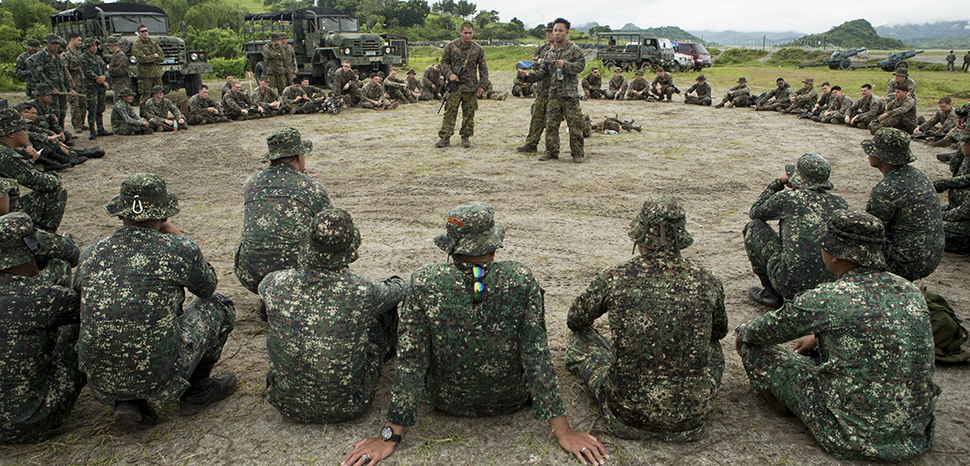On February 2, 2023, news broke about a meeting between the US and Filipino Defense Secretaries allowing the US use of Filipino military bases, suggesting that the total number of bases to be made available to US forces has risen to nine.
The announcement appears to mark a modest shift in Philippines’ president Ferdinand Marcos Junior’s previous position of casting his government as an “enemy to none.” Philippine governments since the early 1990s have traditionally vacillated on the issue of relations with outside countries, particularly the United States and its departure from the Subic Bay naval base in 1992.
At time of publication by the Japanese broadcaster NHK News, it is not clear where exactly these bases are nor their primary missions. The ideal locations for bases that the US would like range from Luzon, Palawan, or the sparsely populated Batanes islands. This is due to their geographic proximity to the disputed islands and territories of the South China Sea, the Chinese mainland, and its consideration of being an integral part of what is termed “island chain strategy.” Under this strategy, the Philippines is part of a string of islands ranging from Japan, through Taiwan and the Philippines, and rounding out the South China Sea with Malaysia, Brunei, and Vietnam. The goal of inception since the Cold War has historically been to counter the spread of communism in the region. And with a resurgent China in recent decades, the strategy has had a philosophical renaissance for US analysts concerned with the East Asian theater.
Besides the strategic first island chain, there are other major factors that play into Washington’s security interests in the wider region. The US and the Philippines have a relationship that began in earnest in 1898 after the former’s victory in the Spanish-American war. Between then and 1946, the archipelago was a colony of the United States. Ever since protests toppled Ferdinand Marcos authoritarian regime, the Philippines has been considered a democracy, making it a natural ally for Washington in the Southeast Asian region.
Strategically, the Philippines flanks the major maritime routes that flow through the South China Sea, which, like with many East Asian nations, is essential to the Philippines’ economy, particularly its northern regions. Long considered a gateway between the Philippine, East China, and South China seas, its geographic position makes it of strategic interest. Culturally and linguistically, the Philippines are related to the Pacific Micronesian and US-aligned Compact of Free Association states to its east (excluding Kiribati), which together make up the “second island chain.”
Rising tensions with China over the past few years have effectively brought Philippine-US diplomatic and military relations closer together; the US and Philippines have held naval exercises as recently as late 2022. As an archipelago, it is particularly dependent on maritime security through which the US acts as a maritime security guarantor. While the Filipino army has had limited engagements of forces in peacekeeping missions and a decades-long insurgency in the Moro region of Mindano in the country’s south, the Filipino navy cannot stand toe-to-toe with the PLA Navy alone. And in pure combined military terms, the Filipino government spends less than 1.25% of its GDP on military expenditures.
Economically, the country has more than tripled its GDP per capita over the past 20 years. Yet the country’s inequality and lack of national infrastructure compared to similarly developed countries means that a good portion of the country’s cash and energy must be earmarked for domestic issues. It could be decades before this balance between Manila’s focus on internal development shifts towards being a more active regional power, paralleling the rise of China.
China’s relatively measured, but still critical, response suggests that it does not view US – Philippine military collaboration as a fundamental threat to its security and integrity in the short to mid-term. With 650 kilometers between the northern most point in the Philippines and mainland China, what Beijing will fear most from the Philippines is the ability of the US and its regional allies to contain Chinese expansion into what Beijing sees as its own backyard. The Philippines’ ex-president Roderigo Duterte even sought for a while to pursue warmer relations with Beijing, which may give confidence to the Chinese that Manila is not a permanent geopolitical lapdog of the United States, or at least not one which will totally disregard or consistently oppose them on every issue.
In the context of domestic Philippine politics and recent history, permitting the use of military bases is a symbolic act, with some potential long-term military implications. The bases are still Filipino, and there is no requirement that the Americans return a permanent military presence to them. But having that option sends a message to Beijing that America fully intends to stand by its commitments to regional partners should regional tensions escalate further.




